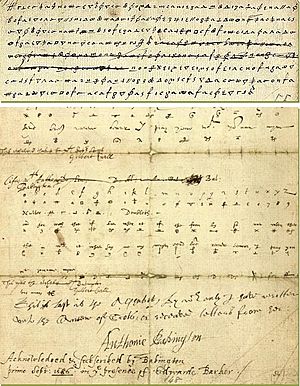Thomas Phelippes facts for kids
Quick facts for kids
Thomas Phelippes
|
|
|---|---|
| Born | 1556 |
| Died | 1625 (aged 68–69) |
| Nationality | English |
Thomas Phelippes (1556–1625) was a very skilled code-breaker and information gatherer. He worked for Sir Francis Walsingham, who was a top advisor to Queen Elizabeth I. Phelippes is most famous for solving the secret messages of people involved in the Babington Plot. This plot was a plan to remove Queen Elizabeth I from power.
Early Life and Amazing Skills
We don't know much about Thomas Phelippes's family. His father was a cloth merchant. Even so, Phelippes likely went to Trinity College in Cambridge in 1569. He finished his studies in 1574.
Phelippes was a brilliant linguist. This means he was great with languages. He could speak French, Italian, Spanish, Latin, and German. His education helped him become an expert in cryptography, which is the art of writing and solving secret codes. Because he was so good at this, Sir Francis Walsingham hired him. Walsingham was the main secretary to Queen Elizabeth I.
People described Phelippes as "a small, lean, yellow-haired, short-sighted man, with pock-marked face." They also said he was an amazing linguist and had a special talent for solving secret letters.
Cracking the Babington Plot Code
Thomas Phelippes is best known for his part in the Babington Plot. This was a plan to kill Queen Elizabeth I and put Mary, Queen of Scots on the throne instead. Phelippes helped uncover the plot by deciphering secret letters.
One very important letter was sent by Mary, Queen of Scots, to Anthony Babington. Phelippes added a special note to this letter. When he sent the letter to Walsingham, proving Mary's involvement, Phelippes even drew a gallows (a structure used for hangings) on the envelope!
Historians say that the secret notes were hidden in empty barrels from a brewer. These barrels were sent to Chartley Manor, where Mary was being held prisoner. Phelippes was very busy. He had to read many letters for the Queen, some about daily life and others that were very secret. Walsingham had to wait seven months to get the proof he needed.
Phelippes's added note asked Babington for the names of everyone involved in the plan to kill Queen Elizabeth I. This helped Sir Francis Walsingham get direct proof that Mary was part of the plot. This evidence led to Mary's execution.
Phelippes also questioned Mary's secretaries and a servant named Jérôme Pasquier in the Tower of London. In September 1586, Pasquier admitted he wrote letters in a secret code for Mary. Pasquier remembered a letter he wrote for the French ambassador, Michel de Castelnau. This letter asked for a pardon for Francis Throckmorton, who was executed in 1584 for his part in the Throckmorton Plot.


